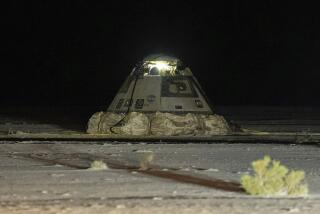PREPARING FOR A Shuttle Launch
- Share via
The multi-million dollar space shuttle undergoes a litany of checks and tests before the launch command is given. Only 10 of NASA’s 56 shuttle missions have lifted off on schedule. The most recent mission, launch of Discovery with a communications satellite, was postponed Saturday for a fifth time.
BEFORE LAUNCH DAY
Seizing the Moment: Timing of launch is critical for astronauts to accomplish their missions, such as deploying or capturing satellites. If ‘window of opportunity’ passes, launch will be rescheduled.
Watching the Weather: Any possibility of extreme cold or hot temperatures, lightning or high winds can cause a delay. Possibility of wind shear conditions at any emergency landing site also could scrub a launch.
Rolling Out: Shuttle, attached to 9-ton mobile launch platform called a “crawler,” is rolled 1 m.p.h. to launch pad. The trek, at Kennedy Space Center in Florida, takes about four hours.
THE COUNTDOWN
Mission Control conducts thousands of tests to ensure that all systems are go and to check for anomalies. Developed in Apollo era of the space program, “T” refers to “time” of takeoff. Critical moments during countdown:
T-2 hours: Astronauts board shuttle; cabin is closed and secured an hour later
T-29 minutes: Main engine undergoes preflight test
T-9 minutes: Weather forecast verified again
T-10 seconds: Systems ignited
T-6 seconds: Booster rockets start
T-zero: Liftoff
POST-LAUNCH SEQUENCE
Once in orbit: It is never too late to abort a mission; if a technical failure occurs, shuttle can land at one of several emergency sites around the world. Edwards Air Force Base in California is primary landing site.
T+8 minutes: Moments before top speed is reached, main tank is jettisoned and disintegrates over Indian Ocean
T+1 minute: Spent rocket boosters are jettisoned into Atlantic Ocean and recovered
Did You Know
* Shuttle is about the same size as a DC-8
* Each shuttle can be reused 100 times
* Average crew size is seven; typical mission lasts a week
Shuttle funding announced in 1972. To date, 167 shuttle astronauts, including 16 foreigners, have flown into space.
WHY DELAYS OCCUR
Overall, shuttle missions have been delayed about 90 times. The decision to scrub can be made months prior to a launch or as close as T-1 second. Missions are often scrubbed several times during the launch sequence. Most common reasons for missions to be rescheduled:
30 scrubs: Fuel leaks or engine problems
28 scrubs: Weather problems, including thunderstorms, extreme temperatures, poor visibility or high winds at launch or emergency landing sites
16 scrubs: Computer or electronic malfunctions
9 scrubs: Other, including waiting for ‘window of opportunity’ to reopen
Source: National Aeronautics and Space Administration
More to Read
Sign up for Essential California
The most important California stories and recommendations in your inbox every morning.
You may occasionally receive promotional content from the Los Angeles Times.










